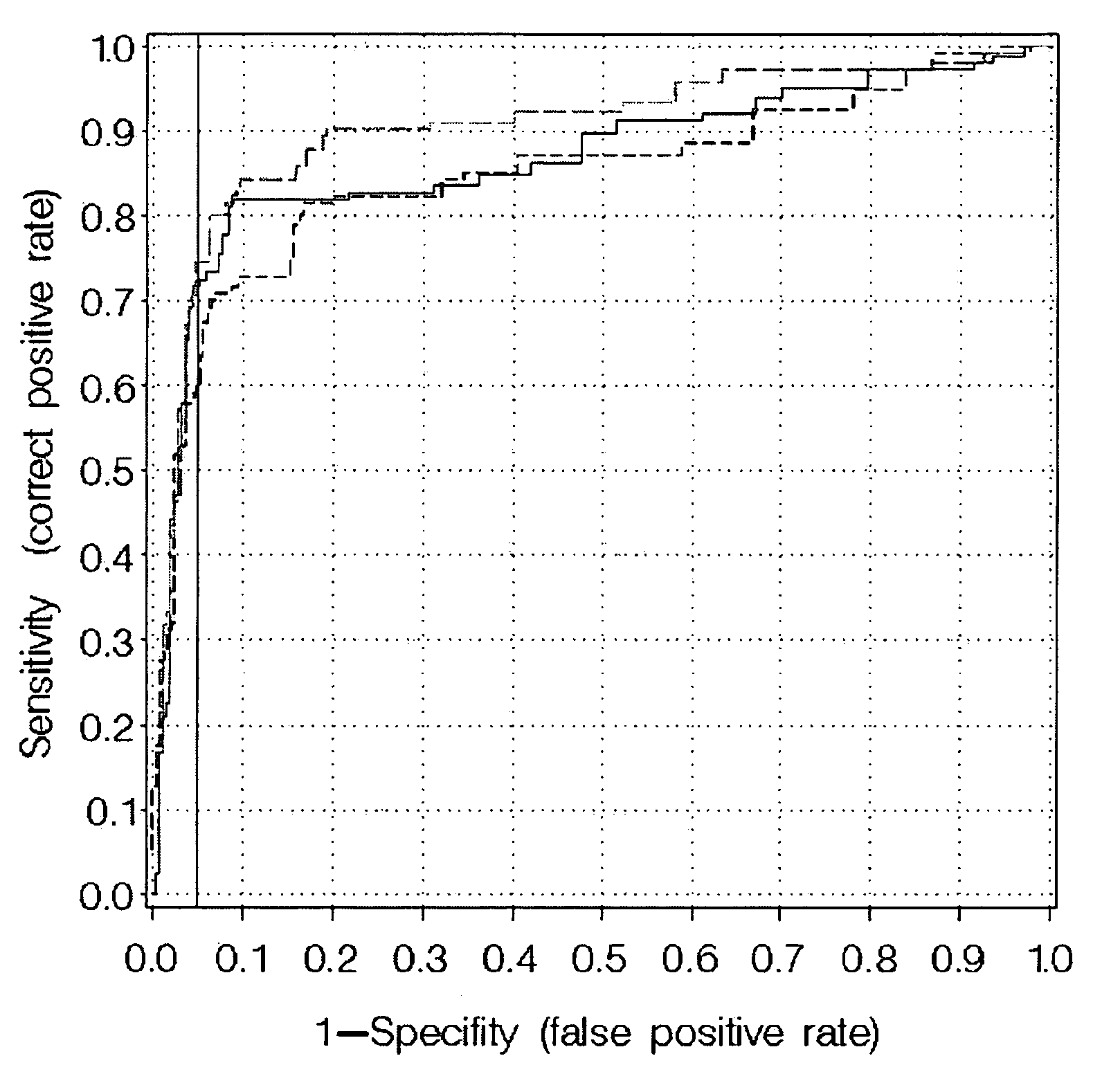Assessing colorectal cancer by measuring hemoglobin and m2-pk in a stool sample
a colorectal cancer and stool sample technology, applied in the direction of material testing goods, biochemistry equipment and processes, instruments, etc., can solve the problems of affecting the quality of life of patients,
- Summary
- Abstract
- Description
- Claims
- Application Information
AI Technical Summary
Benefits of technology
Problems solved by technology
Method used
Image
Examples
example 1
Study Population
[0100]Stool samples derived from 94 well-characterized CRC patients with the UICC classification given in table 1 have been used.
TABLE 1CRC samples and corresponding UICC classificationStage according to UICCNumber of samplesUICC 02UICC I21UICC II27UICC III36UICC I-III (non-IV, classes I to III not8separately staged)Total number of CRC94
[0101]The CRC samples of table 1 have been evaluated in comparison to control samples obtained from individuals, who underwent a colonoscopy and had no adenomas, polyps or colorectal cancers. Table 2 gives an overview of the controls used:
TABLE 2Composition of the control groupType of control patientsNumber of samplesHealthy controls (no evidence of any32bowel disease)Hemorrhoids89Diverticulosis117Other bowel diseases15Total number of controls253
example 2
Extraction of the Stool Samples for the Determination of Hemoglobin and M2-PK
[0102]For each patient investigated, two stool aliquots were collected at different sites of a single feces before a colonoscopy or a surgery was performed. Approx. 1 g in total per stool sample was collected using a specific collecting device from Sarstedt (Id. no. 80.623.022). The such collected stool specimen were frozen as soon as possible and stored at −70° C. until extraction.
[0103]For the determination of hemoglobin 100 mg of the stool specimen was given into a 2 ml Eppendorf-cup per extraction experiment. This 100 mg sample of stool was extracted by using 1 ml of a novel extraction buffer.
[0104]The following extraction buffer was used:
9.49gNa2HPO4 × 2H2O1.84gKH2PO41gNaN30.4gNa2EDTA × 2H2O10mlchicken albumen50mlNonidet P40 10% w / v1tabletComplete mini (Roche Diagnostics, Id. No. 1836145)ad 1 l with bidistilled water
[0105]The stool sample was extracted by shaking the tube comprising the stool specimen ...
example 3
Immunoassays for the Determination of Hemoglobin and M2-PK from an Extract of a Stool Sample
3.1 Hemoglobin
[0107]The hemoglobin determination was performed with the “HaemImmun” assay (Labor Limbach, Heidelberg) according to the instructions given by the manufacturer. 10 μl, of the Hb extract was used as a sample in the immunoassay.
3.2 M2-PK
[0108]The determination of M2-PK was performed with the “SCHEBO Tumor M2-PK” assay (Schebo Biotech AG, Giessen) according to the instructions given by the manufacturer. 50 μL of the M2-PK-extract was used as a sample in this immunoassay.
PUM
| Property | Measurement | Unit |
|---|---|---|
| concentration | aaaaa | aaaaa |
| pH | aaaaa | aaaaa |
| pH | aaaaa | aaaaa |
Abstract
Description
Claims
Application Information
 Login to View More
Login to View More - R&D
- Intellectual Property
- Life Sciences
- Materials
- Tech Scout
- Unparalleled Data Quality
- Higher Quality Content
- 60% Fewer Hallucinations
Browse by: Latest US Patents, China's latest patents, Technical Efficacy Thesaurus, Application Domain, Technology Topic, Popular Technical Reports.
© 2025 PatSnap. All rights reserved.Legal|Privacy policy|Modern Slavery Act Transparency Statement|Sitemap|About US| Contact US: help@patsnap.com



